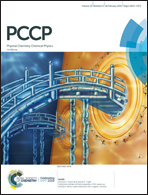The band structure and optical absorption of hematite (α-Fe2O3): a first-principles GW-BSE study†
Abstract
Hematite (α-Fe2O3) is a widely investigated photocatalyst material for the oxygen evolution reaction, a key step in photoelectrochemical water splitting. Having a suitable band gap for light absorption, being chemically stable and based on earth abundant elements, hematite is a promising candidate for the fabrication of devices able to split water using sunlight. What limits its performance is the high rate of bulk recombination following the optical excitation, so that few charge carriers are able to reach the surface to perform the redox reactions. In an effort to better understand the light absorption properties of hematite, in this work we perform a theoretical first-principles investigation of its band structure and optical absorption properties. We use state-of-the-art many-body perturbation theory, including the effects of electron–hole interaction by solving the Bethe–Salpeter equation. Our approach provides good agreement with the available photoemission and absorption measurements and shows that the onset of light absorption is mostly due to ligand-to-metal charge transfer excitations, giving rise to fairly localized excitons. This is at variance with the previously accepted view that these excitations are due to Fe d–d transitions.

- This article is part of the themed collection: 2019 PCCP HOT Articles


 Please wait while we load your content...
Please wait while we load your content...